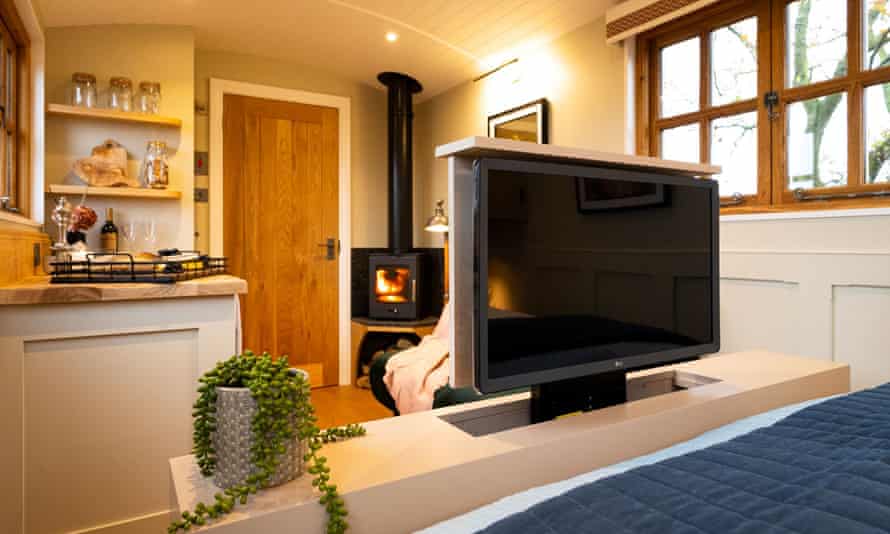David Cameron wrote his memoirs in one; Prince George’s was a gift from his grandfather Prince Charles; and The Archers’ inimitable Linda Snell outraged Joe Grundy by installing a bespoke one in her Ambridge garden.
But if the trend for shepherd’s huts as a lifestyle accessory was already quietly growing, it has been turbo-charged by people working from home and taking staycations due to the pandemic.
So much so that when a ramshackle late Victorian model in the grounds of a country house came up for auction at Charterhouse Auctioneers in Sherborne, Dorset, it s old for £16,000 – 20 times its £800 estimate – as an anonymous London buyer outbid a disappointed local sheep farmer.
“It hadn’t turned a wheel for 50 years. The roof leaked. It was damp. It had woodworm. Generations of bugs, rabbits and rats had probably lived in it,” the auctioneer Richard Bromwell told the Guardian. “My daughter works out of a shepherd’s hut, but ours is a new one, with double-glazed windows and two doors. This had a wooden door, a couple of little windows. It would have held a shepherd, a small fire and somewhere for the guy to sit during lambing.”
The price it attracted was due to its authenticity: very few late Victorian huts survive. “It’s only relatively recently that the huts have become fashionable. And now we’re coming out of a pandemic and a lot of people are working from home,” he added.
Its Dorset rustic charm may be another factor in the bidding war. One of the most famous literary shepherd’s huts is that of Gabriel Oak, described as “a small Noah’s Ark” in Thomas Hardy’s 1874 classic Far from the Madding Crowd, set in rural Dorset.
The Henley Hut Company was born out of the pandemic when the Henley-based global events business was put on hold due to lockdown. Its bespoke, handcrafted shepherd’s huts are far cry from the basic shacks of yore.
Of its ranges, the top-end Oxfordshire, wooden-clad with classic tin roof, boasts hand-forged cast iron wheels, double-glazed windows, heritage ironmongery and hand-carved steps. With underfloor heating, traditional log burner, shower room and handmade shaker kitchen, double bed and storage cabinets, it costs upwards from £45,000.

“The order book is looking very good. On a daily basis we have lots of different inquiries coming through. We are really excited,” said Sam Gryckiewicz, one of the partners.
“We moved in to shepherd’s huts because there is a growing demand for them, as home offices, garden rooms, extra accommodation and for staycations. They can be used for commercial enterprises as well – B&Bs, Airbnb, pubs with rooms, hotels. There is a wide market of uses, including treatment rooms or retail spaces.
“Those involved in glamping or farming are familiar with them. But the general population is now finding out about them as a work-from-home solution. And with staycations on the rise, people are looking for a unique experience.”
Richard Lee, the founder of Plankbridge, near Dorchester, which built Prince George’s hut, said business had increased by 50% in the last six to eight months, split between work-from-home offices and glamping huts for staycation businesses.
“The staycation market is there to be had, and a lot of people are fully booked,” said Lee, whose company has been building huts for 20 years. “In the first lockdown we furloughed the team. Then the number of inquiries started growing and when we came back and were up and running I knew we were going to get very busy. And we are. We’re just flat out now. And we are employing more people. We’ve an awful lot to do.”
With new huts taking time to build, there is inevitable demand also for secondhand huts. Ben Hardman, who blogs about shepherd huts on his sustainable living website tinyecohomelife.com, is getting thousands of hits a month on the subject of secondhand huts.
“It has been growing in the pandemic, going up and up, especially over the summer period when people couldn’t get away,” he said. “Handcrafted new ones are expensive, and can take six to eight weeks to build. So there is a huge backlog. From people I’ve spoken to at the manufacturers, they can’t get them out the door quick enough. So people are turning to secondhand.”
Self-built kits were also becoming more popular, Hardman said. “So that might be the next big thing. Building your own.”
from Lifestyle | The Guardian https://ift.tt/3cea0lb
via IFTTT

comment 0 Comment
more_vert